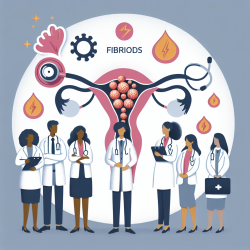Introduction
Uterine fibroids are a significant health issue affecting a substantial number of women globally. A recent study titled "Enhancing Uterine Fibroid Care: Clinician Perspectives on Diagnosis, Disparities, and Strategies for Improving Health Care" provides valuable insights into the challenges and opportunities in fibroid care. This blog aims to help practitioners improve their skills by implementing the outcomes of this research or encouraging further investigation.
Key Findings from the Research
The study identified four main themes:
- Lack of Patient Awareness: Many patients are unaware of fibroids, leading to misconceptions and emotional distress.
- Inequities in Care and Access: Disparities in healthcare access significantly affect Black women and those in rural areas.
- Continuum of Care: Emphasizes the importance of patient-centered care and shared decision-making.
- COVID-19 Impact: The pandemic has both challenged and improved fibroid care, notably through the adoption of telehealth.
Implementing Research Outcomes
1. Enhance Patient Education
Practitioners should prioritize educating patients about fibroids. This can be achieved through:
- Providing comprehensive information during routine gynecological visits.
- Using reputable online resources and handouts.
- Collaborating with public health programs to raise awareness.
2. Address Health Disparities
To mitigate disparities in fibroid care, practitioners should:
- Ensure equitable access to care for all patients, particularly Black women and those in rural areas.
- Advocate for policies that improve transportation and financial support for underserved populations.
3. Foster Interdisciplinary Collaboration
Effective fibroid care requires a multidisciplinary approach. Practitioners should:
- Build networks with specialists such as hematologists, surgeons, and mental health professionals.
- Implement integrated health services that address the physical, emotional, and social aspects of fibroid care.
4. Leverage Telehealth
The COVID-19 pandemic has highlighted the potential of telehealth in fibroid care. Practitioners should:
- Continue using telehealth to reach patients who face barriers to in-person visits.
- Explore nonsurgical treatment options that can be managed remotely.
Encouraging Further Research
While the study provides valuable insights, ongoing research is essential to further improve fibroid care. Practitioners are encouraged to:
- Participate in and support research initiatives focused on fibroid prevention and treatment.
- Stay informed about new treatment modalities, especially minimally invasive options.
Conclusion
By implementing the findings from this study, practitioners can significantly enhance the quality of fibroid care. Improved patient education, addressing health disparities, fostering interdisciplinary collaboration, and leveraging telehealth are crucial steps toward better outcomes for women affected by fibroids.
To read the original research paper, please follow this link: Enhancing Uterine Fibroid Care: Clinician Perspectives on Diagnosis, Disparities, and Strategies for Improving Health Care.










